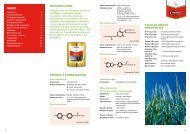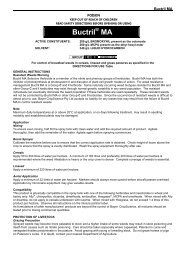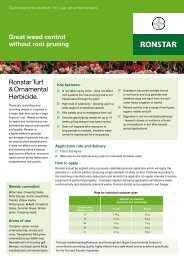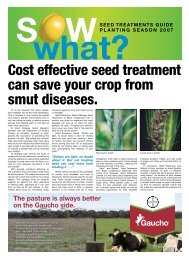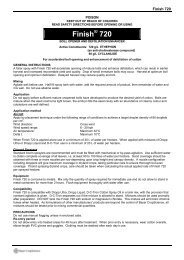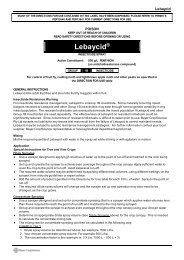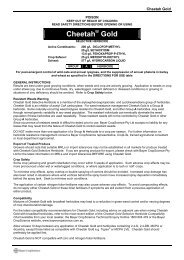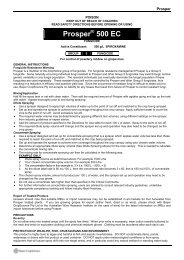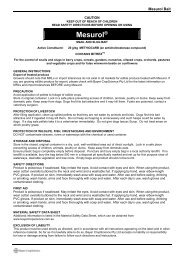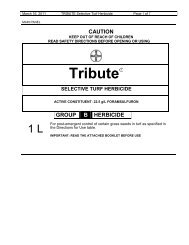Jaguar - Bayer CropScience
Jaguar - Bayer CropScience
Jaguar - Bayer CropScience
You also want an ePaper? Increase the reach of your titles
YUMPU automatically turns print PDFs into web optimized ePapers that Google loves.
<strong>Jaguar</strong><br />
POISON<br />
KEEP OUT OF REACH OF CHILDREN<br />
READ SAFETY DIRECTIONS BEFORE OPENING OR USING<br />
Active Constituents:<br />
Solvents:<br />
<strong>Jaguar</strong> ®<br />
SELECTIVE HERBICIDE<br />
250 g/L BROMOXYNIL present as the octanoate<br />
25 g/L DIFLUFENICAN<br />
416 g/L LIQUID HYDROCARBONS<br />
150 g/L N-METHYL-2-PYRROLIDONE<br />
GROUP C F HERBICIDE<br />
For control of certain broadleaf weeds in winter cereals and pasture as specified in DIRECTIONS FOR USE Table<br />
GENERAL INSTRUCTIONS:<br />
• This product is a post-emergence contact herbicide, which may provide residual control of wild radish up to 4 weeks<br />
after application.<br />
• Apply <strong>Jaguar</strong> Selective Herbicide immediately after mixing. Do not allow to stand in the spray tank overnight.<br />
• Optimum results will be obtained if good soil moisture exists at and after application and weeds are not stressed.<br />
• Some pre-emergence herbicides, such as atrazine, can cause stress to certain crops resulting in an increase in crop<br />
damage when using this product. Crops which are particularly sensitive are lucerne and subterranean clover.<br />
Resistant Weeds Warning<br />
<strong>Jaguar</strong> Selective Herbicide is a member of the nitrile and nicotinanilide groups of herbicides. <strong>Jaguar</strong> is an inhibitor of<br />
photosynthesis at photosystem II and carotenoid biosynthesis. For weed resistance management, <strong>Jaguar</strong> is a Group C,<br />
F herbicide. Some naturally occurring weed biotypes resistant to <strong>Jaguar</strong> and other Group C, F herbicides may exist<br />
through normal genetic variability in any weed population. The resistant individuals can eventually dominate the weed<br />
population if these herbicides are used repeatedly. These resistant weeds will not be controlled by <strong>Jaguar</strong> or other<br />
Group C, F herbicides. Since the occurrence of resistant weeds is difficult to detect prior to use, <strong>Bayer</strong> <strong>CropScience</strong> Pty<br />
Ltd accepts no liability for any losses that may result from the failure of <strong>Jaguar</strong> to control resistant weeds.<br />
Temperature warning<br />
Do not apply <strong>Jaguar</strong> if frosts are imminent. Frost causes stress on crops and weeds and could result in increased crop<br />
effects and/or decreased weed control. To ensure good results <strong>Jaguar</strong> should only be applied once the weeds and crop<br />
are no longer under stress from the frost conditions.<br />
Avoid application when maximum daily temperatures above 20°C occur, or are likely to occur for a few days after<br />
application, as increased crop damage may result.<br />
CROP TOLERANCE<br />
Cereals<br />
After application some transient crop yellowing may occur. This usually appears as yellow or white banding on leaves.<br />
Provided the crop is not under stress from pre-emergent herbicide, root disease, insect damage, frost, dry or excessively<br />
moist conditions, the development of the crop and subsequent growth will be unaffected.<br />
Lucerne<br />
Warning<br />
The tolerance of lucerne varieties to <strong>Jaguar</strong> can vary with rate of application, soil type, crop health, stage of growth and<br />
degree of moisture and temperature stress. <strong>Jaguar</strong> may result in transient crop yellowing and suppression of growth with<br />
a resultant initial reduction in dry matter. For this reason we recommend application prior to the 8 trifoliate leaf stage.<br />
However, under normal growing conditions subsequent growth and seed yield should not be affected. Crop damage may<br />
be increased if rates higher than 500 mL/ha are used and in areas where spray overlapping has occurred.<br />
Under normal growing conditions, the following lucerne varieties have shown acceptable levels of foliage tolerance to<br />
<strong>Jaguar</strong> applied at 500 mL/ha: Hunter River, Nova and Dekalb 185. Varieties not listed should be tested before using<br />
<strong>Jaguar</strong> over large areas.<br />
Consult your local <strong>Bayer</strong> <strong>CropScience</strong> representative for advice on specific varieties.<br />
Subterranean clover<br />
Warning<br />
The tolerance of subterranean clover varieties to <strong>Jaguar</strong> can vary with rate of application, soil type, crop health, stage of<br />
growth and degree of moisture and temperature stress. <strong>Jaguar</strong> may result in transient crop yellowing and suppression of<br />
growth with an initial reduction in dry matter. For this reason we recommend application prior to the 8 trifoliate leaf stage.<br />
However, under normal growing conditions subsequent growth and seed yield should not be affected. Crop damage may<br />
be increased if rates higher than 500 mL/ha are used and in areas where spray overlapping has occurred.
<strong>Jaguar</strong><br />
Under normal growing conditions, the following varieties have shown acceptable levels of foliage tolerance to <strong>Jaguar</strong><br />
applied at 500 mL/ha:<br />
Daliak, Dalkeith, Denmark, Goulburn, Karridale, Leura, Mt. Barker, Nungarin, Rosedale, Seaton Park, Trikkala and<br />
Woogenellup.<br />
The variety Junee has shown increased sensitivity to <strong>Jaguar</strong> so care should be taken if this variety is part of the pasture<br />
sward.<br />
The effects of <strong>Jaguar</strong> on subterranean clover seed yield have been tested on the following varieties. Under normal<br />
growing conditions they show acceptable levels of tolerance to <strong>Jaguar</strong> applied at 500 mL/ha. However, higher rates may<br />
reduce seed yield under conditions of low weed pressure:<br />
Denmark, Goulburn, Larissa, Nungarin, Seaton Park, Trikkala and Woogenellup.<br />
Varieties not listed should be tested before using <strong>Jaguar</strong> over large areas. Consult your local <strong>Bayer</strong> <strong>CropScience</strong><br />
representative for advice on specific varieties.<br />
Other Clovers<br />
Warning<br />
The tolerance of clover varieties to <strong>Jaguar</strong> can vary with rate of application, soil type, crop health, stage of growth and<br />
degree of moisture and temperature stress. <strong>Jaguar</strong> may result in transient crop yellowing and suppression of growth with<br />
a resultant initial reduction in dry matter. For this reason we recommend application prior to the 8 trifoliate leaf stage.<br />
However, under normal growing conditions subsequent growth and seed yield should not be affected. Crop damage may<br />
be increased if rates higher than 500 mL/ha are used and in areas where spray overlapping has occurred. The effect on<br />
seed yield of other clovers has not been determined.<br />
The following varieties of clover have shown increased sensitivity to <strong>Jaguar</strong> : Big Bee, Sacromonte (Berseem), Haifa<br />
(White), Zulu (Arrowleaf), Kyambro, Lupers and Maral (Persian).<br />
Care should be exercised if these clovers are part of the pasture sward.<br />
Varieties not listed should be tested before using <strong>Jaguar</strong> over large areas.<br />
Consult your local <strong>Bayer</strong> <strong>CropScience</strong> representative for advice on specific varieties.<br />
Subsequent Crops<br />
To reduce effect on subsequent susceptible crops (e.g. canola), ensure thorough cultivation of soil prior to the sowing of<br />
these crops.<br />
MIXING<br />
To ensure even mixing, half fill the spray tank with clean water and add the required amount of product. Agitate<br />
thoroughly while carrying out spray operations. Reseal part-used container immediately after use.<br />
APPLICATION<br />
Boom Sprayer<br />
A minimum of 50 L water/ha should be used, however, for optimum results water rates of 70-100 L/ha are recommended.<br />
Increase the water volume where weed infestation is heavy or the crop cover is dense. Complete coverage of weeds is<br />
essential. Higher water volumes (up to 100 L/ha) will ensure faster activity of the product on the weeds but may increase<br />
the symptoms of crop damage.<br />
The following settings are examples which will ensure excellent coverage of exposed weeds:<br />
Water Rate 50 L/ha 75 L/ha 75 L/ha<br />
Nozzle Hardi No. 10 or equivalent Hardi No. 12 or equivalent Hardi No. 14 or equivalent<br />
Speed 10 km/h 10 km/h 12 km/h<br />
Pressure 240 kPa (2.4 bar) 220 kPa (2.2 bar) 210 kPa (2.1 bar)<br />
Controlled Droplet Application (CDA)<br />
Insufficient information is available to recommend the application of this product by CDA.<br />
Warning<br />
The rubber components present in some spraying units may be affected by exposure to the solvents in <strong>Jaguar</strong>. To<br />
reduce this risk it is recommended that the spray unit be thoroughly washed with a boom cleaner and fresh water after<br />
use.<br />
Aircraft<br />
Insufficient information is available to recommend the application of this product by air.
<strong>Jaguar</strong><br />
COMPATIBILITY<br />
The following herbicide products are physically compatible with <strong>Jaguar</strong> as two-way mixtures in the spray tank, but should<br />
only be used for the crops specified, and only when the crop is also specified on the label of the compatible product:<br />
(See below for list of compatibile insecticides.)<br />
Crop <strong>Jaguar</strong> Compatible Product<br />
Wheat, triticale, cereal rye<br />
(including undersown)<br />
Up to 750 mL/ha Hoegrass ® (barley also), Tristar ® Advance (barley also), Wildcat ® 110<br />
EC (wild oats only, high rate)<br />
Wheat, barley, triticale, All rates Broadstrike ®<br />
cereal rye (including<br />
undersown)<br />
Wheat, barley, triticale, Up to 500 mL/ha Ally ® , Glean ® , MCPA LVE (500 g/L product) (up to 500 mL/ha only)<br />
cereal rye (not undersown) All rates<br />
2,4-D amine 500, Eclipse ® , Cadence ® (up to 115 g only), Lontrel ®<br />
Wheat only (not undersown)<br />
Topik ®<br />
Established lucerne only Up to 750 mL/ha Simazine (500 g/L product) (up to 1.25 L/ha only) and simazine (500<br />
g/L)/paraquat (200 g/L) mixture<br />
Newly sown and established Up to 750 mL/ha Targa ® , Fusilade ® , 2,4-DB amine (500 g/L)<br />
lucerne<br />
and clover only<br />
Up to 1.0 L/ha Broadstrike ®<br />
When mixing <strong>Jaguar</strong> with other herbicides, crop yellowing may be enhanced.<br />
When mixing with Hoegrass ® , Wildcat ® 110 EC or Tristar ® Advance some reduction in the efficacy and speed of action of<br />
these products may occur.<br />
When mixing with Targa ® or Fusilade ® some reduction in the efficacy and speed of action of these products and <strong>Jaguar</strong><br />
may occur.<br />
In tank-mixtures with Ally ® and Glean ® , rates of <strong>Jaguar</strong> higher than 500 mL/ha may cause significant crop damage.<br />
If the crop is stressed, the application of the herbicide tank-mixtures may cause yield reduction.<br />
When mixing with Cadence ® a temporary wilting may be evident in some crops after application.<br />
The mixture of <strong>Jaguar</strong> and simazine should be applied during winter to lucerne which is not actively growing. This<br />
mixture may result in an increased crop effect but this can be reduced if the lucerne is grazed or cut before spraying.<br />
DO NOT mix <strong>Jaguar</strong> with Verdict ® .<br />
Growers should seek advice before spraying recently released cereal varieties.<br />
This product may be mixed in the spray tank with one of the following insecticides according to the directions for the<br />
insecticide product: Chlorpyrifos (500 g/L product), Decis Options ® , dimethoate, Dominex ® 100EC, Fastac ® Duo, Le-mat ®<br />
290 SL, Talstar ® and Thiodan ® .<br />
Use the recommended rates for <strong>Jaguar</strong> and its tank-mix partner as well as the surfactant recommendation of the tankmix<br />
partner. Read the label of the tank-mix partner before mixing and using the tank mixture. If another herbicide is<br />
applied as a tank mix, observe the plantback restrictions on that label.<br />
Warning<br />
DO NOT use crop oils with <strong>Jaguar</strong> or <strong>Jaguar</strong> tank mixtures in cereals.<br />
As formulations of other manufacturers' products are beyond the control of <strong>Bayer</strong> <strong>CropScience</strong>, all mixtures should be<br />
tested prior to mixing commercial quantities.<br />
PROTECTION OF CROPS, NATIVE AND OTHER NON-TARGET PLANTS<br />
DO NOT apply under weather conditions, or from spraying equipment, that may cause spray to drift onto nearby<br />
susceptible plants/crops, cropping lands or pastures. Wash sprayer thoroughly after use.<br />
PROTECTION OF WILDLIFE, FISH, CRUSTACEANS AND ENVIRONMENT<br />
Dangerous to fish. DO NOT contaminate streams, rivers or waterways with the chemical or used containers.<br />
STORAGE AND DISPOSAL<br />
Store in the closed, original container in a cool, well-ventilated area. Do not store for prolonged periods in direct sunlight.<br />
5 L,and 20 L containers<br />
Triple or preferably pressure rinse containers before disposal. Add rinsings to spray tank. Do not dispose of undiluted<br />
chemicals on site. If recycling, replace cap and return clean containers to recycler or designated collection point. If not<br />
recycling, break, crush, or puncture and bury empty containers in a local authority landfill. If no landfill is available, bury<br />
the containers below 500 mm in a disposal pit specifically marked and set up for this purpose clear of waterways,<br />
desirable vegetation and tree roots. Empty containers and product should not be burnt. Do not use empty container for<br />
any other purpose.<br />
110 L returnable containers<br />
If tamper evident seals are broken prior to initial use then the integrity of the contents cannot be assured. Empty<br />
container by pumping through dry-break connection system. Do not attempt to breach the valve system or the filling<br />
point, or contaminate the container with water or other products. Ensure that the coupler, pump, meter and hoses are<br />
disconnected, triple rinsed with clean water and drained after each use. When empty, or contents no longer required,<br />
return the container to the point of purchase. This container remains the property of <strong>Bayer</strong> <strong>CropScience</strong> Pty Ltd.
<strong>Jaguar</strong><br />
1000 L containers<br />
If tamper evident seals are broken prior to initial use then the integrity of the contents cannot be assured. The container<br />
must be vented before discharging contents. To empty, connect a camlock fitted hose to the bottom valve. Remove top<br />
cap when discharging for venting purposes. When the container is empty, close all caps and valves and return the<br />
container to the point of purchase.<br />
SAFETY DIRECTIONS<br />
Product is harmful if inhaled or swallowed. Will irritate eyes, nose, throat and skin. Avoid inhaling spray mist. When<br />
preparing spray wear elbow length PVC gloves and face-shield. If product in eyes, wash it out immediately with water.<br />
After use and before eating, drinking or smoking, wash hands, arms and face thoroughly with soap and water. After each<br />
day's use wash gloves, face shield and contaminated clothing.<br />
FIRST AID<br />
If poisoning occurs contact a doctor or Poisons Information Centre (telephone 13 11 26). If swallowed, DO NOT induce<br />
vomiting. Give a glass of water. If in eyes, wash out immediately with water.<br />
MATERIAL SAFETY DATA SHEET<br />
Additional information is listed in the Material Safety Data Sheet, which can be obtained from<br />
www.bayercropscience.com.au.<br />
EXCLUSION OF LIABILITY<br />
This product must be used strictly as directed, and in accordance with all instructions appearing on the label and in other<br />
reference material. So far as it is lawfully able to do so, <strong>Bayer</strong> <strong>CropScience</strong> Pty Ltd accepts no liability or responsibility<br />
for loss or damage arising from failure to follow such directions and instructions.<br />
Decis Options ® , Eclipse ® , Hoegrass ® , <strong>Jaguar</strong> ® , Thiodan ® , Tristar ®<br />
and Wildcat ® are Registered Trademarks of <strong>Bayer</strong>.<br />
APVMA Approval No. 40383/0108<br />
FOR 24 HOUR SPECIALIST ADVICE<br />
IN EMERGENCY ONLY<br />
PHONE 1800 033 111<br />
WEEDS LIST<br />
WEED (Common name) (Scientific name) WEED (Common name) (Scientific name)<br />
Amsinckia Amsinckia spp. Mouse-eared chickweed Cerastium glomeratum<br />
Ball mustard Neslia paniculata New Zealand spinach Tetragonia<br />
tetragonoides<br />
Canola (rapeseed) Brassica napus Ox-tongue Picris echioides<br />
Capeweed Arctotheca calendula Paterson's curse (Salvation Echium plantagineum<br />
Jane)<br />
Chamomile<br />
Matricaria<br />
Pheasants eye (adonis)<br />
Adonis dentatus<br />
matricarioides<br />
Charlock Sinapis arvensis Prickly lettuce Lactuca serriola<br />
Chickweed Stellaria media Purple calandrinia (mountain Calandrinia menziesii<br />
sorrel)<br />
Cleavers Galium aparine Rough poppy Papaver hybridum<br />
Climbing buckwheat Fallopia convolvulus Saffron thistle Carthamus lanatus<br />
Common cotula (bird's eye) Cotula australis Scarlet pimpernel Anagallis arvensis<br />
Common peppercress Lepidium africanum Shepherd's purse Capsella bursapastoris<br />
Common sowthistle (milk thistle) Sonchus oleraceus Skeleton weed Chondrilla juncea<br />
Corn gromwell Buglossoides arvense Sorrel Rumex acetosella<br />
Crassula (stonecrop) Crassula spp. Speedwell Veronica spp.<br />
Deadnettle Lamium amplexicaule Spoon cudweed Stuartina muelleri<br />
Dense-flower fumitory Fumaria densiflora Three-horned bedstraw Galium tricornutum<br />
Dock Rumex spp. Toad rush Juncus bufonius<br />
Doublegee (spiny emex) Emex australis Tree hogweed Polygonum patulum<br />
Fat hen Chenopodium album Turnip weed Rapistrum rugosum<br />
Field madder Sherardia arvensis Variegated thistle Silybum marianum<br />
Fireweed Senecio spp. Vetch Vicia sativa<br />
Fumitory Fumaria spp. Volunteer field peas Pisum sativum<br />
Hexham scent (King Island Melilotus indicus Volunteer lupins Lupinus angustifolius<br />
melilot)<br />
Horehound Marubium vulgare Ward's weed Carrichtera annua<br />
Lesser swinecress Coronopus didymus Wild mustard Sisymbrium spp.<br />
Long storksbill Erodium botrys Wild radish Raphanus<br />
raphanistrum<br />
Marshmallow Malva parviflora Wild turnip Brassica tournefortii<br />
Mexican poppy Argemone ochroleuca Wireweed Polygonum aviculare<br />
Mintweed<br />
Salvia reflexa
<strong>Jaguar</strong><br />
DIRECTIONS FOR USE<br />
Restraints<br />
DO NOT apply if crop or weeds are stressed due to dry or excessively moist conditions.<br />
DO NOT apply to crops under stress due to disease or insect damage.<br />
DO NOT apply to frost-affected crops or if frosts are imminent.<br />
DO NOT apply if heavy rain is expected within 4 hours.<br />
DO NOT apply with crop oils (cereals only).<br />
CROP<br />
Wheat,<br />
barley,<br />
triticale,<br />
cereal rye<br />
(including<br />
undersown<br />
with clover<br />
and/or<br />
lucerne), and<br />
these cover<br />
crops in<br />
vineyards<br />
WEEDS<br />
CONTROLLED<br />
Wild radish<br />
Wild mustard<br />
Wild radish<br />
Pasture<br />
Clover and/or<br />
lucernebased<br />
pasture<br />
(newly sown<br />
or<br />
Canola<br />
established) (rapeseed)<br />
including charlock<br />
cover crops turnip weed<br />
in vineyards wild turnip<br />
Shepherd's purse<br />
Capeweed<br />
WEED STAGE RATE/<br />
HA<br />
STATE<br />
Up to 2 leaf stage 350 mL WA only<br />
plants/m 2<br />
and not more than 60<br />
mm in diameter and<br />
where weed density<br />
is less than 50<br />
Up to 4 leaf stage 500 mL All States<br />
and not more than<br />
120 mm in diameter<br />
Up to 6 leaf stage<br />
and not more than<br />
150 mm in diameter<br />
Up to 8 leaf stage<br />
and not more than<br />
180 mm in diameter<br />
Up to 2 leaf stage<br />
and not more than 60<br />
mm in diameter<br />
Up to 4 leaf stage<br />
and not more than<br />
120 mm<br />
in diameter<br />
Up to 4 leaf stage<br />
and not more than<br />
120 mm in diameter<br />
Up to 6 leaf stage<br />
and not more than<br />
150 mm in diameter<br />
Up to 8 leaf stage<br />
and not more than<br />
180 mm in diameter<br />
750 mL<br />
1.0 L<br />
500 mL<br />
750 mL<br />
1.0 L<br />
500 mL<br />
750 mL<br />
1.0 L<br />
Corn gromwell Up to 4 leaf stage 500 mL<br />
Up to 6 leaf stage 750 mL<br />
Climbing Up to 2 leaf stage 500 mL<br />
buckwheat Up to 4 leaf stage 750 mL<br />
Up to 6 leaf stage 1.0 L<br />
Deadnettle, Up to 2 leaf stage 500 mL<br />
Paterson's curse,<br />
(Salvation Jane),<br />
rough poppy<br />
Amsinckia<br />
Up to 4 leaf stage 750 mL<br />
Doublegee Up to 2 leaf stage 500 mL Qld, NSW,<br />
(spiny emex)<br />
ACT, Vic,<br />
Tas, WA<br />
only<br />
Up to 4 leaf stage 750 mL All States<br />
CRITICAL COMMENTS<br />
CROP STAGE:<br />
Cereals<br />
2 leaf to fully tillered<br />
(Zadok’s Z12-29)<br />
Optimum results are achieved when sprayed<br />
at 4-8 weeks post-sowing.<br />
Warning: <strong>Jaguar</strong> may cause transient crop<br />
yellowing of cereals. (Refer to "Crop<br />
Tolerance section of General Instructions).<br />
Clover and lucerne<br />
Application is recommended prior to the 8th<br />
trifoliate leaf stage. Application can be made<br />
from the 1st trifoliate leaf stage in Qld, NSW,<br />
ACT and Vic only. In other States<br />
applications prior to the 3 leaf stage may<br />
result in crop damage if seedlings are under<br />
stress and in sandy soils.<br />
DO NOT apply to annual medics.<br />
Warning: <strong>Jaguar</strong> may affect growth and<br />
seed set of some varieties of clover and<br />
lucerne<br />
(Refer to "Crop Tolerance" section of<br />
General Instructions).<br />
COVER CROPS IN VINEYARDS: When<br />
using in vineyard situations, apply during<br />
vine dormancy only. Contact with vines must<br />
be avoided. Particular care should be taken<br />
if applied in late autumn or early spring,<br />
when vines may not be fully dormant.<br />
WEED STAGE:<br />
Apply from early post-emergence.<br />
APPLICATION:<br />
Apply when weeds are actively growing.<br />
Ensure thorough coverage of weeds. Where<br />
crop or weed density is high, increase water<br />
volume.<br />
CONTINUED ON NEXT PAGE
<strong>Jaguar</strong><br />
CROP<br />
Wheat, barley,<br />
triticale, cereal<br />
rye (including<br />
undersown with<br />
clover and/or<br />
lucerne), and<br />
these cover crops<br />
in vineyards<br />
Pasture<br />
Clover and/or<br />
lucerne-based<br />
pasture (newly<br />
sown or<br />
established)<br />
including cover<br />
crops in<br />
vineyards<br />
Wheat, barley,<br />
triticale, cereal<br />
Rye<br />
Wheat, barley,<br />
triticale, cereal<br />
rye (including<br />
undersown with<br />
clover and/or<br />
lucerne), and<br />
these cover crops<br />
in vineyards<br />
Pasture<br />
Clover and/or<br />
lucerne-based<br />
pasture (newly<br />
sown or<br />
established)<br />
including cover<br />
crops in<br />
vineyards<br />
WEEDS<br />
CONTROLLED<br />
Chamomile,<br />
common<br />
peppercress,<br />
lesser swinecress,<br />
purple calandrinia,<br />
(mountain sorrel),<br />
tree hogweed<br />
Fat hen,<br />
field madder,<br />
saffron thistle,<br />
variegated thistle<br />
WEED STAGE RATE/HA STATE CRITICAL COMMENTS<br />
Up to 4 leaf stage.<br />
1.1 L<br />
1.0 L<br />
All States<br />
Ox-tongue,<br />
Up to 2 leaf stage<br />
wireweed<br />
Fireweed Up to 4 leaf stage 500 mL Qld, NSW, ACT,<br />
Vic, SA, WA, NT<br />
only<br />
Common cotula<br />
(bird’s eye)<br />
pheasants eye<br />
(adonis)<br />
Up to 4 leaf stage<br />
Greater than 4 leaf<br />
stage<br />
560 mL<br />
1.1 L<br />
Fumitory 2-6 leaf stage 350 + 200<br />
mL/ha<br />
terbutryn<br />
(500 g/L)<br />
Suppression of the Following Weeds<br />
Dense-flower fumitory Up to 2 leaf stage 750 mL<br />
Up to 4 leaf stage 1.0 L<br />
Chickweed,<br />
common sowthistle,<br />
(milk thistle),<br />
dock#,<br />
hexham scent,<br />
(King Island melilot),<br />
prickly lettuce,<br />
scarlet pimpernel,<br />
skeleton weed,<br />
sorrel,<br />
speedwell,<br />
three-horned<br />
bedstraw,<br />
toad rush<br />
SA only<br />
WA only<br />
All States<br />
Volunteer lupins<br />
500 mL -1.0<br />
L<br />
Crassula<br />
Up to 5 leaf stage 500 mL<br />
(stonecrop)<br />
Long storksbill Up to 4 leaf stage<br />
Volunteer field peas Up to 5 node stage 750 mL<br />
Ward's weed Up to 5 leaf stage 1.0 L<br />
Vetch<br />
Up to 2 leaf stage<br />
Mouse-eared<br />
NSW & ACT<br />
chickweed<br />
only<br />
Mexican poppy<br />
Qld only<br />
Mintweed,<br />
Up to 4 leaf stage<br />
NSW & ACT<br />
spoon cudweed<br />
only<br />
New Zealand spinach Up to 2 leaf stage 750 mL Qld only<br />
Cleavers<br />
Up to 1 whorl stage 1.0 L SA only<br />
Ball mustard Up to 4 leaf stage<br />
Horehound<br />
Pre-emergence<br />
Marshmallow Up to 2 leaf stage<br />
CONTINUED FROM<br />
PREVIOUS PAGE<br />
In most situations the rate<br />
specified for each weed size<br />
will give satisfactory control.<br />
However, under certain<br />
conditions such as:<br />
* high crop and weed<br />
density,<br />
* late season<br />
germinations,<br />
* abnormal weed growth<br />
(including early flowering);<br />
higher rates of product (up to<br />
the maximum rate of<br />
application specified for that<br />
weed) may be required.<br />
<strong>Jaguar</strong> will not effectively<br />
control:<br />
* regrowth of suppressed<br />
weeds,<br />
* transplanted weeds,<br />
* regrowth from rhizomes<br />
or roots,<br />
* weeds growing under<br />
stress from previous<br />
herbicide applications.<br />
* Radish plants beyond<br />
rosette stage<br />
WILD RADISH:<br />
Effective residual activity of<br />
this product may be reduced<br />
where:<br />
* rates lower than 1.0 L/ha<br />
are used;<br />
* dry conditions prevail;<br />
* poor coverage of the soil<br />
surface is achieved;<br />
* crop is grown in nonwetting<br />
sand;<br />
* soils have a high content<br />
of clay or organic matter.<br />
VOLUNTEER LUPINS:<br />
In some situations, the higher<br />
rate of 1.0 L/ha may be<br />
required to effectively<br />
suppress volunteer lupins at<br />
the 4 leaf stage.<br />
# <strong>Jaguar</strong> will suppress<br />
seedling dock but will not<br />
suppress regrowth from<br />
transplanted roots.
<strong>Jaguar</strong><br />
CROP<br />
Wheat,<br />
barley,<br />
triticale,<br />
cereal rye<br />
WEED<br />
CONTROLLED<br />
Wild radish<br />
WEED STAGE RATE/HA STATE CRITICAL COMMENTS<br />
Up to the 4 leaf<br />
stage and not more<br />
than 120 mm in<br />
diameter<br />
Up to the 6 leaf<br />
stage and not more<br />
than 150 mm in<br />
diameter<br />
Up to the 8 leaf<br />
stage and not more<br />
than 180 mm in<br />
diameter.<br />
350 mL<br />
plus 200<br />
mL MCPA<br />
LVE (500<br />
g/L)<br />
500 mL<br />
plus 200<br />
mL MCPA<br />
LVE (500<br />
g/L)<br />
500 mL<br />
plus 400<br />
mL MCPA<br />
LVE (500<br />
g/L)<br />
WA<br />
only<br />
All<br />
States<br />
Refer also to all Critical Comments for<br />
cereals above.<br />
DO NOT use this tank-mix if cereals are<br />
undersown with lucerne or annual medics.<br />
DO NOT use this tank-mix in vineyards.<br />
Crop Stage<br />
<strong>Jaguar</strong> 350 mL + MCPA LVE 200 mL: Apply<br />
from 3 leaf to fully tillered (Zadok’s Z13 to<br />
Z30).<br />
<strong>Jaguar</strong> 500 mL + MCPA LVE 200 mL: Apply<br />
from 3 leaf to fully tillered (Zadok’s Z13 to<br />
Z30).<br />
<strong>Jaguar</strong> 500 mL + MCPA LVE 400 mL: Apply<br />
from 5 leaf stage to fully tillered (Zadok’s Z15<br />
to Z30).<br />
Optimum results are achieved when sprayed<br />
at 4-8 weeks post sowing.<br />
Warning: <strong>Jaguar</strong> may cause<br />
transient crop yellowing of cereals. (Refer to<br />
"Crop Tolerance" section of General<br />
Instructions)<br />
Observe instructions also on MCPA LVE<br />
product label.<br />
NOT TO BE USED FOR ANY PURPOSE OR IN ANY MANNER CONTRARY TO THIS LABEL UNLESS AUTHORISED<br />
UNDER APPROPRIATE LEGISLATION.<br />
WITHHOLDING PERIOD<br />
Harvest: Cereals, Grapes – NOT REQUIRED WHEN USED AS DIRECTED<br />
Grazing: Pasture, Cereals – DO NOT GRAZE OR CUT FOR STOCK FOOD WITHIN 14 DAYS AFTER APPLICATION.



